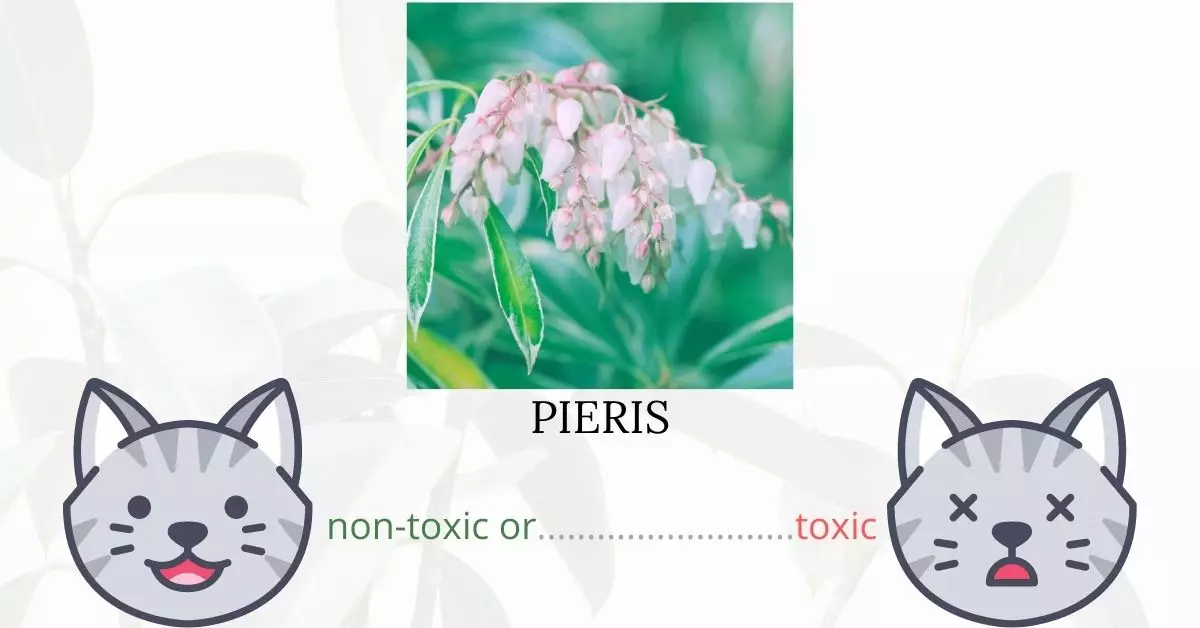Pieris, indeed, is toxic to cats due to its high concentration of grayanotoxins, substances known for causing severe health issues in various species. Grayanotoxin primarily serves as a defense mechanism for the plant, deterring potential predators by inducing unpleasant sensations and serious health concerns. It is a neurotoxin found not only in Pieris but also in plants like Rhododendron, compromising the functioning of afflicted organs by disrupting the transmission of electrical impulses within the nervous system.
This article is the product of collaborative efforts with a team of experienced Doctors of Veterinary Medicine (DVMs), whose valuable contributions have enriched our understanding of the potential risks associated with various plants, Pieris in this instance, and their impact on cats. Through their insights, we endeavor to offer precise and current information to safeguard the well-being of our feline companions. Moreover, to ensure the reliability and accuracy of the information presented, extensive research has been conducted utilizing high-authority resources, including ASPCA and PetMD, which are renowned for their comprehensive knowledge on pet health and safety.
Clinical Signs of Pieris Poisoning in Cats
When a cat comes into contact, inhales, or ingests the Pieris plant, it can exhibit a range of symptoms due to the toxic grayanotoxins present in the plant. The severity and range of symptoms may differ, depending on the amount of plant material consumed or contacted. Here’s a detailed look at the clinical signs and the underlying reasons for their occurrence:
- Excessive Salivation: This occurs as a response to the irritation and burning sensation in the mouth caused by the grayanotoxins. It’s the body’s reflex mechanism to flush out the harmful substances.
- Perspiration on Nose and Footpads: This is indicative of distress and discomfort, a bodily response to the systemic effects of the toxin.
- Vomiting and Diarrhea: These are common gastrointestinal reactions, as the body attempts to expel the ingested toxic elements swiftly.
- Weakness: The body’s energy is diverted to combat the toxin, resulting in overall lethargy and weakness.
- Burning or Numbness around the Mouth and Extremities: The neurotoxic effect of grayanotoxins disrupts normal nerve function, leading to these sensations.
- Low Blood Pressure: The toxin may impact the cardiovascular system, reducing blood pressure significantly.
- Sinus Bradycardia: This refers to a slower-than-normal heart rate, induced by the effect of the toxin on the heart’s sinus node.
- Loss of Coordination and Muscle Weakness: The interference of grayanotoxins with neural transmissions may cause impaired coordination and weakened muscles.
- Ventricular Tachycardia: The toxicity induces abnormal electrical activities in the heart, leading to a rapid heart rate.
- Coma: In severe cases, the cumulative effect of the toxicity can overwhelm the cat’s system, leading to a loss of consciousness or coma.
Each clinical sign is the body’s way of responding to, and coping with, the toxic effects of the Pieris plant. Immediate veterinary attention is crucial if a cat is suspected to have come into contact with or consumed this plant, to mitigate the adverse effects and prevent any long-term damage.
First Aid and Treatment of Pieris Poisoning in Cats
One of the most common treatments for plant poisoning in cats is fluid therapy. This method will keep your cat hydrated and prevent dehydration caused by diarrhea and vomiting for an extended period of time. The vet may perform gastric lavage to prevent more poison from entering the cat’s body.
Activated charcoal can be given to the cat to neutralize any toxins that may still be present in the intestines. Atropine is sometimes used to relieve symptoms of severe cardiac problems, but it is usually reserved as a last resort.
Recovery from Pieris Poisoning in Cats
Grayanotoxins, fortunately, are rapidly metabolized and excreted, so animals that have only consumed a small amount will begin to feel better within hours, and heart rate and blood pressure will usually return to normal within two to nine hours.
Full recovery of cats is expected in 24 hours. If a larger amount of the plant was consumed, the recovery may take longer than usual.
Prevention of Pieris Poisoning in Cats
Restrict your cats’ access outdoors. If necessary, build fences and place safety nets around your house. Utilize cat houses and playpens to keep your cat entertained and stimulated.
If you love plants but have cats at home, check out these lists:





